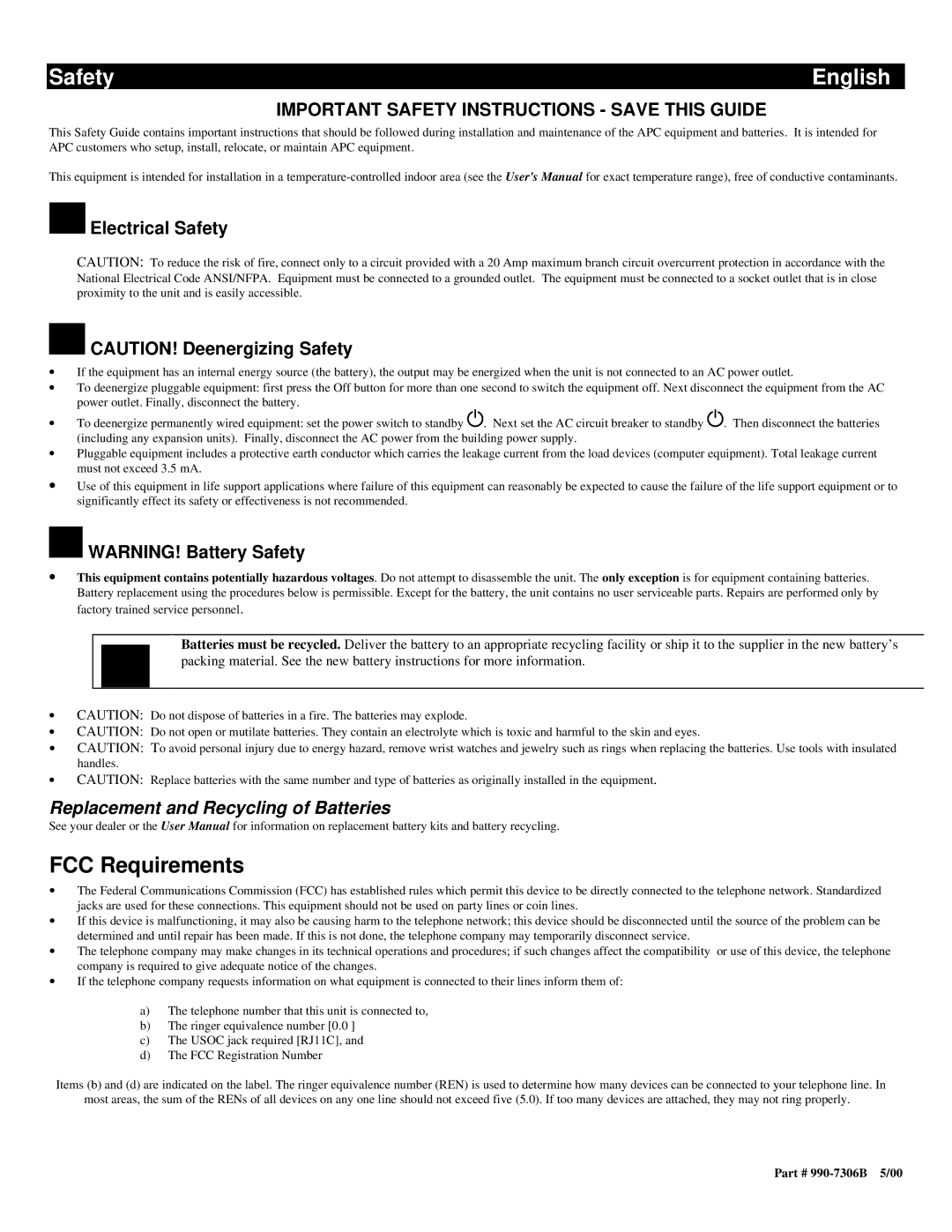
Safety | English |
IMPORTANT SAFETY INSTRUCTIONS - SAVE THIS GUIDE
This Safety Guide contains important instructions that should be followed during installation and maintenance of the APC equipment and batteries. It is intended for APC customers who setup, install, relocate, or maintain APC equipment.
This equipment is intended for installation in a
 Electrical Safety
Electrical Safety
CAUTION: To reduce the risk of fire, connect only to a circuit provided with a 20 Amp maximum branch circuit overcurrent protection in accordance with the National Electrical Code ANSI/NFPA. Equipment must be connected to a grounded outlet. The equipment must be connected to a socket outlet that is in close proximity to the unit and is easily accessible.
![]()
![]() CAUTION! Deenergizing Safety
CAUTION! Deenergizing Safety
∙If the equipment has an internal energy source (the battery), the output may be energized when the unit is not connected to an AC power outlet.
∙To deenergize pluggable equipment: first press the Off button for more than one second to switch the equipment off. Next disconnect the equipment from the AC power outlet. Finally, disconnect the battery.
∙To deenergize permanently wired equipment: set the power switch to standby ![]() . Next set the AC circuit breaker to standby
. Next set the AC circuit breaker to standby ![]() . Then disconnect the batteries (including any expansion units). Finally, disconnect the AC power from the building power supply.
. Then disconnect the batteries (including any expansion units). Finally, disconnect the AC power from the building power supply.
∙Pluggable equipment includes a protective earth conductor which carries the leakage current from the load devices (computer equipment). Total leakage current must not exceed 3.5 mA.
∙Use of this equipment in life support applications where failure of this equipment can reasonably be expected to cause the failure of the life support equipment or to significantly effect its safety or effectiveness is not recommended.
![]()
![]() WARNING! Battery Safety
WARNING! Battery Safety
∙This equipment contains potentially hazardous voltages. Do not attempt to disassemble the unit. The only exception is for equipment containing batteries. Battery replacement using the procedures below is permissible. Except for the battery, the unit contains no user serviceable parts. Repairs are performed only by factory trained service personnel.
Batteries must be recycled. Deliver the battery to an appropriate recycling facility or ship it to the supplier in the new battery’s packing material. See the new battery instructions for more information.
∙CAUTION: Do not dispose of batteries in a fire. The batteries may explode.
∙CAUTION: Do not open or mutilate batteries. They contain an electrolyte which is toxic and harmful to the skin and eyes.
∙CAUTION: To avoid personal injury due to energy hazard, remove wrist watches and jewelry such as rings when replacing the batteries. Use tools with insulated handles.
∙CAUTION: Replace batteries with the same number and type of batteries as originally installed in the equipment.
Replacement and Recycling of Batteries
See your dealer or the User Manual for information on replacement battery kits and battery recycling.
FCC Requirements
∙The Federal Communications Commission (FCC) has established rules which permit this device to be directly connected to the telephone network. Standardized jacks are used for these connections. This equipment should not be used on party lines or coin lines.
∙If this device is malfunctioning, it may also be causing harm to the telephone network; this device should be disconnected until the source of the problem can be determined and until repair has been made. If this is not done, the telephone company may temporarily disconnect service.
∙The telephone company may make changes in its technical operations and procedures; if such changes affect the compatibility or use of this device, the telephone company is required to give adequate notice of the changes.
∙If the telephone company requests information on what equipment is connected to their lines inform them of:
a)The telephone number that this unit is connected to,
b)The ringer equivalence number [0.0 ]
c)The USOC jack required [RJ11C], and
d)The FCC Registration Number
Items (b) and (d) are indicated on the label. The ringer equivalence number (REN) is used to determine how many devices can be connected to your telephone line. In most areas, the sum of the RENs of all devices on any one line should not exceed five (5.0). If too many devices are attached, they may not ring properly.
Part #
